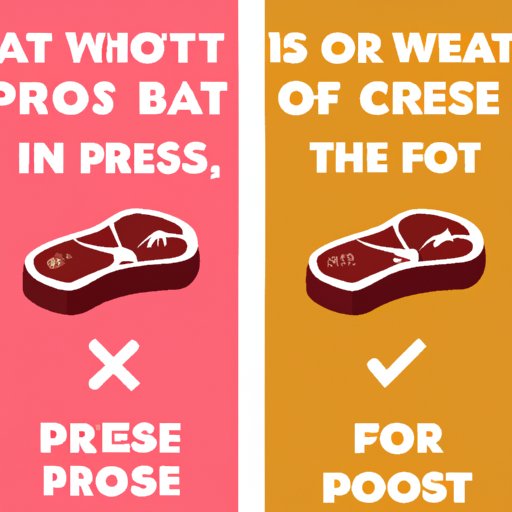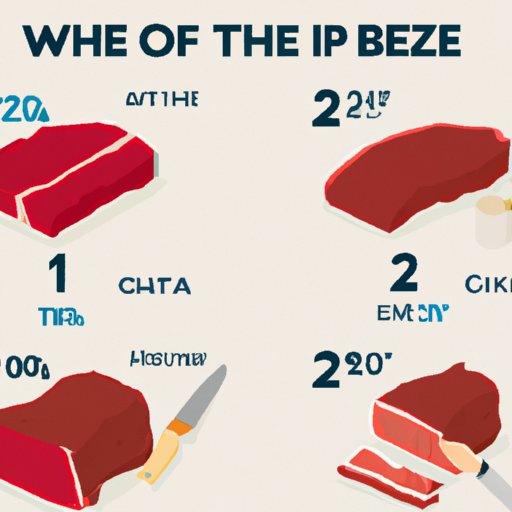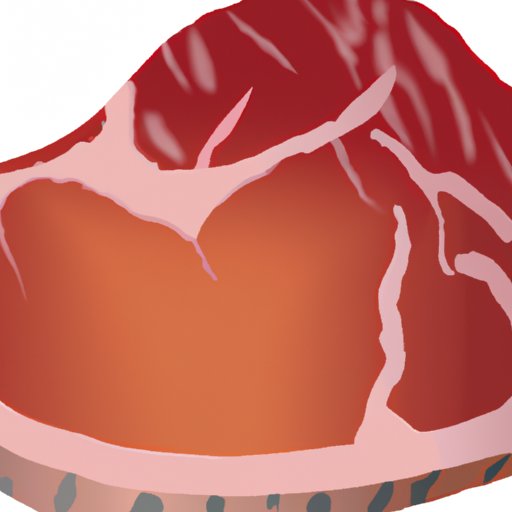Introduction
It’s no surprise that steak is one of the most popular types of meat in the world. Whether it’s barbecued, grilled, broiled, or stir-fried, there are so many delicious ways to enjoy steak. But when it comes to nutrition, is steak healthy? And if so, what are the nutritional benefits of eating steak?
This article will explore the potential health benefits and risks of eating steak. We’ll look at the nutrition content of steak, discuss how to choose the healthiest cut of steak, and compare the nutrition of red meat versus white meat. We’ll also investigate the impact of processed meats on health and explore different ways to cook healthy steak.
Nutritional Benefits of Eating Steak
Steak is an excellent source of protein, essential vitamins, and minerals. According to the United States Department of Agriculture (USDA), a 4-ounce serving of lean sirloin steak contains 28 grams of protein, 2.6 grams of fat, and 0 grams of carbohydrates.
In addition to being high in protein, steak is also a good source of essential vitamins and minerals. A 4-ounce serving of sirloin steak contains 10% of the daily recommended value of iron, 20% of the daily recommended value of zinc, and 6% of the daily recommended value of vitamin B12.
Finally, steak also contains healthy fats. A 4-ounce serving of lean sirloin steak contains 1.3 grams of monounsaturated fat and 0.4 grams of polyunsaturated fat. Monounsaturated and polyunsaturated fats are beneficial for heart health and can help reduce cholesterol levels.

Pros and Cons of Eating Steak
Eating steak has both potential health benefits and potential health risks. On the plus side, steak is an excellent source of protein, essential vitamins, and minerals, and it contains healthy fats. Eating steak may help you meet your daily nutrient requirements and provide your body with the fuel it needs to stay energized.
On the downside, steak is high in saturated fat, which has been linked to an increased risk of heart disease. Additionally, some cuts of steak are high in calories, which can lead to weight gain if consumed in excess. Finally, processed meats such as bacon, hot dogs, and deli meats can be high in sodium, nitrates, and other chemicals, which may increase the risk of certain diseases.

How to Choose the Healthiest Cut of Steak
When choosing the healthiest cut of steak, it’s important to look for lean cuts. The USDA recommends looking for cuts that are labeled “loin” or “round”, such as sirloin, tenderloin, or top round. These cuts are usually lower in fat and calories than other cuts of steak.
It’s also important to avoid processed meats such as bacon, hot dogs, and deli meats. Processed meats are often high in sodium, nitrates, and other chemicals, which may increase the risk of certain diseases.

Exploring Different Ways to Cook Healthy Steak
There are many different ways to cook steak, but some methods are healthier than others. Grilling and broiling are two of the healthiest ways to cook steak because they don’t require the use of additional fats or oils. Stir-frying is another healthy option because it requires only a small amount of oil.
It’s important to avoid cooking methods that involve deep-frying or coating the steak in butter or other unhealthy fats. These methods can significantly increase the calorie and fat content of the steak.
Comparing Nutrition of Red Meat Versus White Meat
When it comes to nutrition, red meat and white meat have some similarities and some differences. Both red meat and white meat are good sources of protein, but red meat tends to be higher in fat and calories than white meat. For example, a 4-ounce serving of lean sirloin steak contains 28 grams of protein, 2.6 grams of fat, and 0 grams of carbohydrates, while a 4-ounce serving of skinless chicken breast contains 27 grams of protein, 1 gram of fat, and 0 grams of carbohydrates.
When it comes to vitamins and minerals, red meat and white meat have similar nutrient profiles. Both are good sources of iron, zinc, and vitamin B12, although red meat is typically higher in these nutrients than white meat.
Investigating the Impact of Processed Meats on Health
Processed meats such as bacon, hot dogs, and deli meats can be high in sodium, nitrates, and other chemicals, which may increase the risk of certain diseases. Studies have shown that consuming large amounts of processed meats can increase the risk of colorectal cancer, heart disease, and type 2 diabetes.
If you’re looking for an alternative to processed meats, try lean cuts of steak or poultry. These types of meat are low in fat and calories and can provide your body with the protein and nutrients it needs without the added chemicals found in processed meats.
Conclusion
In conclusion, steak can be a healthy part of your diet if you choose the right cut and cooking method. Look for lean cuts of steak such as sirloin, tenderloin, or top round and avoid processed meats such as bacon, hot dogs, and deli meats. When cooking steak, opt for grilling, broiling, or stir-frying instead of deep-frying or coating the steak in butter or other unhealthy fats.
Red meat and white meat have similar nutrient profiles, although red meat tends to be higher in fat and calories. However, processed meats can be high in sodium, nitrates, and other chemicals, which may increase the risk of certain diseases. If you’re looking for an alternative to processed meats, try lean cuts of steak or poultry.
In summary, steak can be a healthy part of your diet if you choose the right cut and cooking method. Eating steak can provide your body with the protein, vitamins, and minerals it needs to stay energized and healthy.
(Note: Is this article not meeting your expectations? Do you have knowledge or insights to share? Unlock new opportunities and expand your reach by joining our authors team. Click Registration to join us and share your expertise with our readers.)
